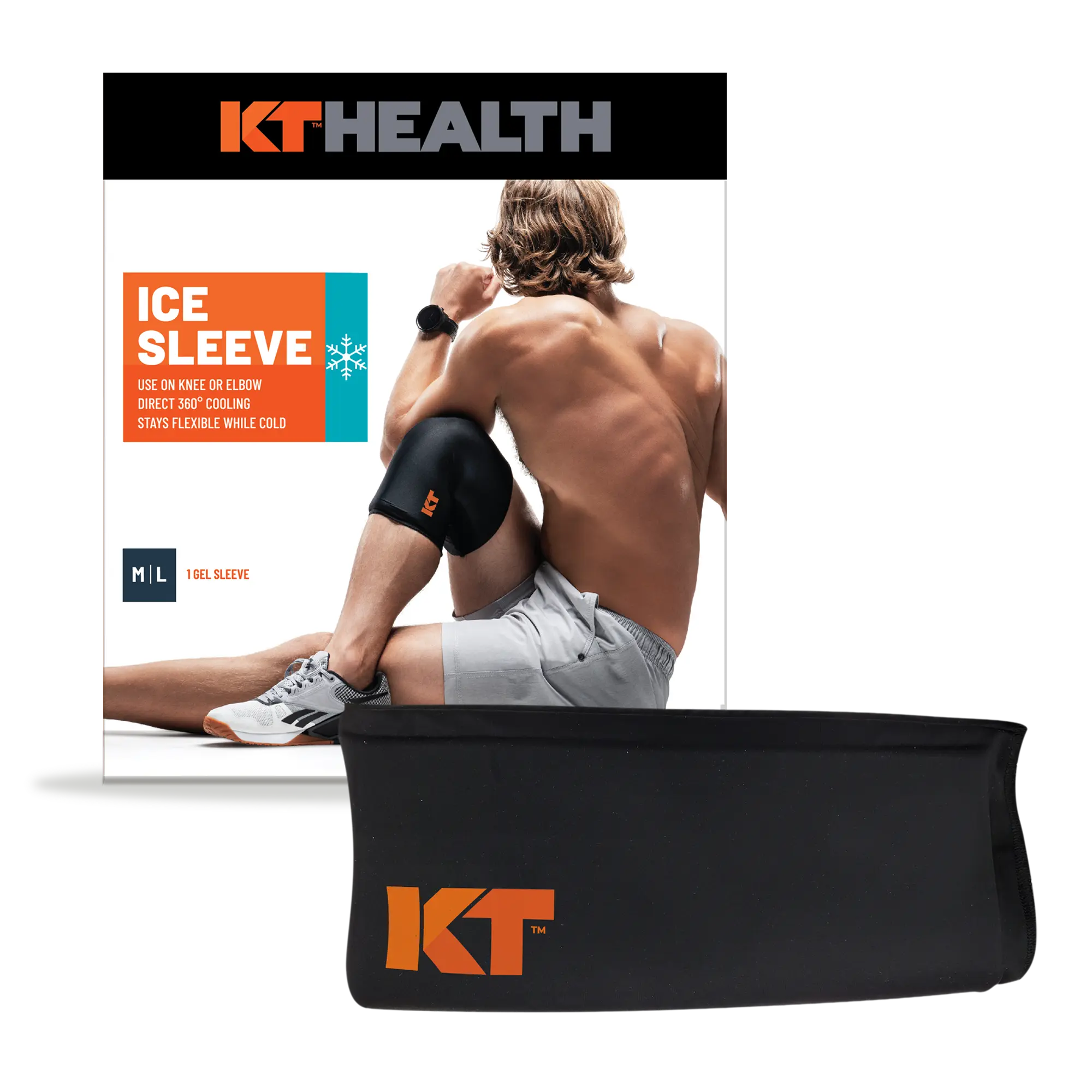Crushing backhands on the tennis court, swinging for the fences in softball, and powering through your upper-body day at the gym are all great, until elbow pain shows up and throws a serious wrench in your game. Maybe you've tried stretching, heat, or compression sleeves, but have you ever considered using KT Tape elbow applications?
This flexible, stretchy tape has earned a loyal following among athletes and active folks looking for non-pharmaceutical options to stay comfortable and supported. But does KT Tape elbow support actually work for pain and performance?
Emerging research suggests it might. One study found that kinesiology taping can support muscle function and performance, even in populations with muscular challenges, indicating its potential as a helpful tool for managing strain and discomfort during movement.
Another study published in JOSPT highlights its potential to modulate pain and enhance muscle activation, even in clinical populations. While the science is still evolving, many users report meaningful relief and better mobility, especially when KT Tape is part of a broader recovery strategy.
Let’s break it down.
KT Tape and Elbow Pain Relief
Before we get into the tape talk, it helps to understand what might be behind that annoying ache or tightness in your elbow.
Here are a few common culprits:
-
Tennis elbow (lateral epicondylitis): Caused by overusing the forearm muscles that extend your wrist and fingers. It shows up as pain on the outer part of the elbow.
-
Golfer’s elbow (medial epicondylitis): This one hits the inside of your elbow, often due to repetitive wrist flexion (like gripping or swinging).
-
Elbow tendonitis: General inflammation of the tendons that connect muscle to bone. Often the result of repetitive motion — think lifting, throwing, or typing.
-
Elbow hyperextension: This happens when the elbow bends too far back, potentially straining ligaments or soft tissues.
No matter the source, KT Tape has become a go-to tool for many people looking for support and relief without having to stop doing what they love and is an option worth considering.
How Does KT Tape Work for Elbow Pain?
KT Tape for elbow pain (short for Kinesiology Therapeutic Tape) isn’t just colorful athletic tape. It’s made from a breathable cotton blend or synthetic Pro(R) fabric with a medical-grade adhesive, designed to move with your body.
But what’s it actually doing?
Here’s a quick science-backed explanation:
-
Lifts the skin slightly: This microscopic lift helps reduce pressure on the underlying tissues, which may support better circulation and lymphatic drainage.
-
Supports muscles and joints: Without restricting motion, KT Tape offers gentle support that can help you feel more stable and confident.
-
Promotes movement awareness: Sometimes just having the tape on reminds your body to move differently or more mindfully, which is helpful when recovering from overuse injuries.
Studies have shown mixed results about its physiological effects, but many users report reduced discomfort and increased mobility, especially when paired with other recovery tools.

Common Elbow Conditions Addressed by KT Tape
KT Tape is often used as a supportive tool for managing various elbow issues, particularly those related to overuse or repetitive strain. KT Tape is not clinically proven for all injuries or applications, but is effective for many common elbow pain issues. By gently lifting the skin and creating space in the underlying tissues, it can help reduce localized pressure and provide structural support. Here's how KT Tape may relate to some of the most common elbow concerns.
Tennis Elbow (Lateral Epicondylitis)
This is one of the most frequently mentioned conditions when talking about elbow pain. It typically affects athletes like tennis players and climbers, but it’s just as common among people who spend hours typing, lifting, or doing DIY work. The pain shows up on the outside of the elbow, where the forearm’s extensor tendons attach. Applying KT Tape in this area can offer targeted support to those wrist extensors. As it slightly offloads the stressed tissue, the tape may help you feel more comfortable during activity while also improving your body’s awareness of the movement pattern. If you want a deeper look at what causes this condition and how to manage it, we recommend checking out this guide on tennis elbow.
Golfer’s Elbow (Medial Epicondylitis)
This condition affects the inner part of the elbow, typically as a result of repetitive wrist flexion, which is something that happens not just in golf, but in weightlifting, racquet sports, or even activities like painting or typing. The inside elbow tendons become irritated from overuse, leading to pain or tenderness that can radiate down the forearm.
KT Tape can be applied to help support the forearm flexor muscles and reduce strain during movement. While some people turn to rigid braces for relief, many prefer a more flexible, movement-friendly solution. Here’s a useful comparison of taping versus bracing for golfer’s elbow to help you choose the approach that fits your lifestyle.
Elbow Tendonitis
Elbow tendonitis is a broader term that includes both tennis and golfer’s elbow and refers to general irritation or inflammation of the tendons surrounding the joint. Whether it’s from throwing, lifting, or performing the same motion day after day, this kind of repetitive stress can gradually wear down the soft tissues and cause lingering discomfort.
KT Tape offers a customizable option for addressing either inner or outer elbow pain. When applied correctly, the tape can be tailored to support the specific tendons that are most affected, encouraging better movement patterns and easing some of the day-to-day strain.
Elbow Hyperextension
This condition occurs when the elbow joint bends past its natural range, which can stretch or irritate the surrounding ligaments and soft tissue. This often happens during sports that involve rapid arm movement, like football, weightlifting, or gymnastics. While rest is typically part of the recovery process, some people use KT Tape to add a bit of reinforcement during their return to activity.
Taping the elbow in a slightly flexed position may offer mild external support and serve as a physical cue to avoid pushing the joint too far, which is especially helpful during workouts or drills when your focus is elsewhere.
How to KT Tape an Elbow for Support and Recovery: Step-by-Step Guide
Thinking of giving KT Tape a try? There are specific taping techniques depending on the type of elbow discomfort you're dealing with. Here's a straightforward guide to help you get started.
For tennis elbow, you'll need two strips of KT Tape—one full-length and one half-length. Begin by applying the base of the longer strip a few inches below your elbow, along the outer part of your forearm. As you lay the tape across the area of pain, apply a light stretch, finishing the strip above the elbow. Next, take the shorter piece and place it over the sore spot in an “X” pattern. Apply a moderate stretch to this strip to help provide extra support where it’s needed most.
If you're taping for golfer’s elbow or experiencing inner elbow tendonitis, the method is similar, but the positioning changes. This time, apply the longer strip along the inside of your forearm and guide it across the inner part of the elbow joint. Then, use the second strip to form an “X” shape directly over the area where you're feeling discomfort. This helps support the flexor tendons and reduce strain during movement.
For elbow hyperextension, start by placing an anchor point with your first strip just below the elbow. Then, stretch the tape across the back of the elbow joint and secure it above the elbow to limit excessive backward motion. A second, shorter strip can be placed horizontally across the joint for added reinforcement, especially useful during activity or recovery phases.
Each technique is designed to offer targeted support without restricting your range of motion. If you're new to taping, following along with a video tutorial on how to apply KT Tape on elbow, or consulting with a physical therapist can also help ensure proper application.
Best Practices: Tips for Using KT Tape on the Elbow
To make the most of your taping experience, keep these tips in mind:
-
Clean and dry your skin before applying the tape — sweat and lotion are not its friends.
-
Apply tape before or after activity, depending on your goal. Some people prefer taping ahead of movement for added support, while others use it during downtime to assist recovery.
-
Pair it with other recovery tools like rest, stretching, or an ice sleeve for a well-rounded approach.
-
Don’t overstretch the tape; most techniques work best with light to moderate tension.
-
Rub the tape after applying to activate the adhesive and help it stay in place.
KT Tape vs. Braces and Compression Sleeves
So how does KT Tape stack up against other options like braces or sleeves?
Here’s a quick breakdown:
|
Feature |
KT Tape |
Braces / Compression Sleeves |
|
Flexibility |
High – allows full range of motion |
Moderate – can restrict movement |
|
Breathability |
Excellent |
Varies |
|
Support Level |
Light to moderate |
Moderate to firm |
|
Use during activity |
Great for dynamic movement |
Can be bulky or restrictive |
|
Ease of application |
Takes practice |
Just slip on and go |
Who Should Consider Using KT Tape for Elbow Pain?
KT Tape can be a great option if:
-
You’re an athlete or active person looking for support without bulky equipment
-
You’re dealing with mild or moderate elbow discomfort from overuse
-
You want a non-invasive, drug-free tool to support recovery
-
You need a discreet option that can easily be worn under a shirt while you go about your day
However, it’s not a one-size-fits-all solution. If your elbow pain is sharp, persistent, or tied to swelling or bruising, it's a good idea to check in with a medical professional. Taping may be a helpful part of a bigger recovery plan, not the whole thing.
When to Consult a Professional
Even with a well-applied tape job, some issues call for expert input.
Consider speaking with a physical therapist or physician if:
-
You’re experiencing ongoing elbow discomfort that doesn’t improve
-
You’ve got numbness, tingling, or muscle weakness — which could signal nerve involvement
-
Your pain began after a fall, impact, or overextension
-
You’re unsure how to apply the tape correctly or need help integrating it into your recovery
Is KT Tape Effective for Elbow Pain?
KT Tape isn’t a miracle fix but it can be a really useful tool in your self-care kit. Using the right KT tape elbow method for your specific type of discomfort and following a few best practices might help you move more comfortably and confidently. Many people find that KT Tape offers just enough reinforcement to stay active without added strain.
It’s worth giving it a shot. If it brings a bit of ease to your elbow, that’s a win worth sticking with.











